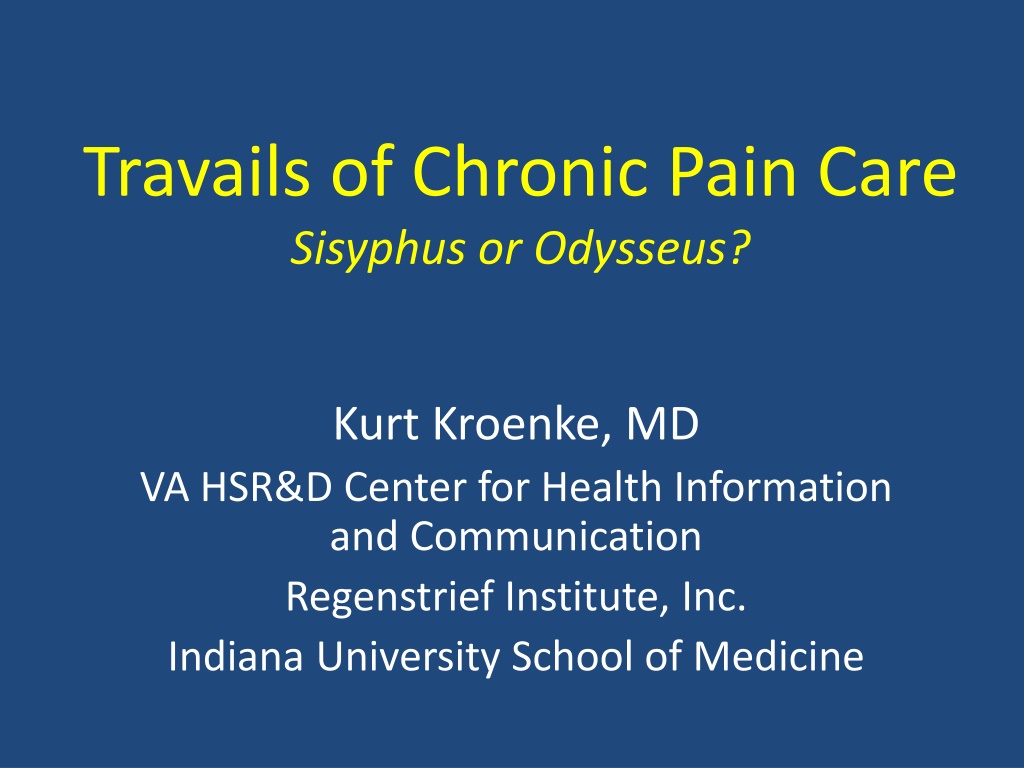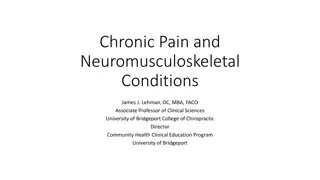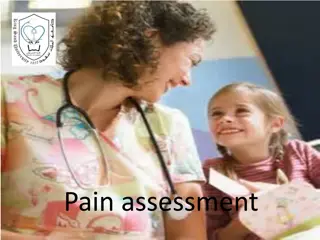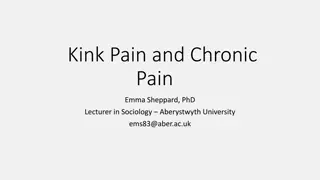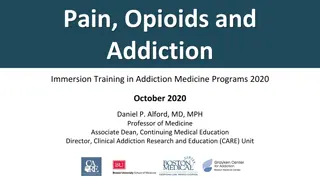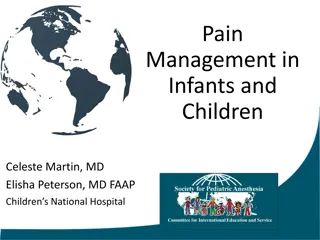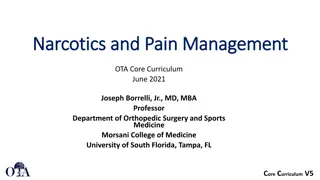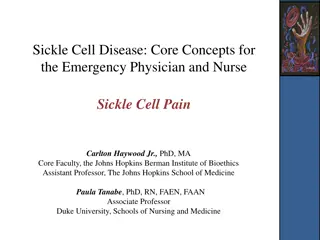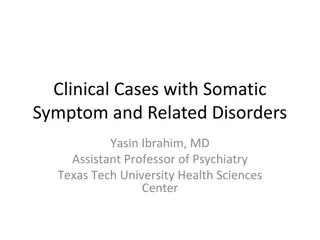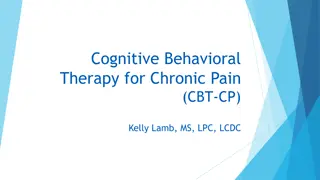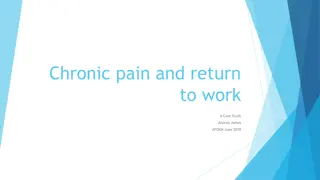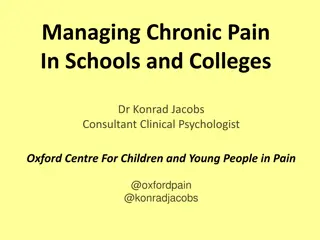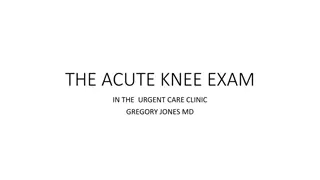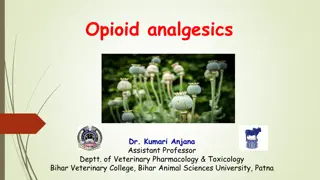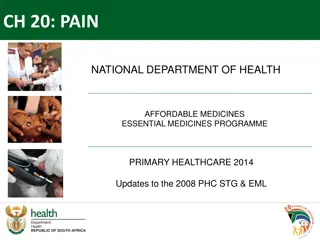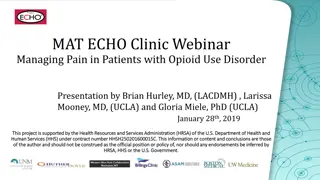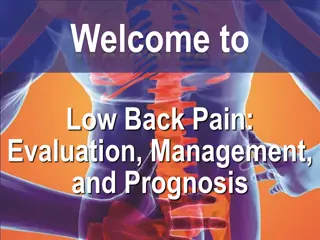The Burden of Chronic Pain: A Critical Examination
Chronic pain is a significant public health issue impacting millions of Americans and costing billions annually. Psychological factors, response measurement, and treatment efficacy play crucial roles. However, funding for pain research remains disproportionately low compared to its prevalence and impact on society.
Download Presentation

Please find below an Image/Link to download the presentation.
The content on the website is provided AS IS for your information and personal use only. It may not be sold, licensed, or shared on other websites without obtaining consent from the author. Download presentation by click this link. If you encounter any issues during the download, it is possible that the publisher has removed the file from their server.
E N D
Presentation Transcript
Travails of Chronic Pain Care Sisyphus or Odysseus? Kurt Kroenke, MD VA HSR&D Center for Health Information and Communication Regenstrief Institute, Inc. Indiana University School of Medicine
Outline 1. Investment/Disability ratio is tiny 2. Pain is seldom solitary 3. Psychological factors are salient 4. Measuring response is important 5. Treatment is a cup half full
Years Lived with Disability . (JAMA 2013;310:591-608) Depression/Anxiety 6 million YLDs COPD (6) Diabetes (8) Asthma (10) Alcoholism (12) Dementia (13) Ischemic heart disease (16) Stroke (17) Hearing loss (19) Chronic kidney disease (22) Vision loss (26) Road injury (27) Epilepsy (30) Low back pain (1) Neck pain (4) Other musculoskeletal (5) Osteoarthritis (9) Migraine (14) P A I N 9.7 million YLDs 8.8 million YLDs
Institute of Medicine: 2011 Report Chronic pain affects > 100 million American adults more than the total affected by heart disease, cancer, and diabetes combined. Pain also costs the U.S. $635 billion each year in medical treatment and lost productivity. http://snapl.stanford.edu/wp-content/uploads/2014/03/IOM-report.png
Pain by the Numbers 30% of U.S. adults (116 million) have chronic pain 20% of all outpatient visits and 10% of all drug sales 80% of patients undergoing surgery have post- operative pain; < 50% report adequate pain relief. 60% of those visiting emergency department with acute pain receive analgesics (median = 1 hr.); 74% are discharged in moderate to severe pain. 62% of U.S. nursing home residents report pain 60% of women report severe pain with first child birth 1 trillion dollars annual costs to developed countries Institute of Medicine, 2011; Max, National Rev Drug Discov 2008
Pain Research Funding as % of NIH Total Budget (2003-2007) 0.78% 0.75% 0.71% 0.67% 0.61% Bradshaw J Pain 2008
NIH Pain When NIH times get tough, pain funding gets tougher
Pain Research Funding as % of Individual NIH Institute Budgets (2003-2007)
Outline 1. Investment/Disability ratio is tiny 2. Pain is seldom solitary 3. Psychological factors are salient 4. Measuring response is important 5. Treatment is a cup half full
Chronic Pain is Seldom Solitary # Pain Sites 1 2 3 4 5-6 7-10 11 % Patients 7.6% 12.4% 19.2% 18.0% 16.8% 15.2% 10.8% SCOPE Trial (n = 250), Kroenke, JAMA 2014
SPADE Symptom Cluster S leep P ain A nxiety D epression E nergy
SPADE Prevalence in Primary Care PROMIS 4-item symptom scale T-score 55 SPADE Symptoms 0 1 2 3 4 5 Chronic Pain (n=250) 9.6 % 20.0 % 15.6 % 22.8 % 11.6 % 20.4 % SPADE screen + (n=300) 5.3 % 11.0 % 13.0 % 18.0 % 21.3 % 31.3 % Davis, Kroenke, et al, Clin J Pain 2015; Kroenke et al, in preparation
Polytrauma P3 triad in 340 OIF/OEF Veterans (Lew et al, JRRD 2009)
The SAD Triad Lowe et al, Gen Hosp Psychiatry 2008 PHQ scores 15 Pure forms of: Depression = 26% Anxiety = 43% Somatization = 46% 15 primary care clinics (n = 2091 patients)
Outline 1. Investment/Disability ratio is tiny 2. Pain is seldom solitary 3. Psychological factors are salient 4. Measuring response is important 5. Treatment is a cup half full
Pain & Depression http://garden-services.com/gallery/garden_clipart/images/chicken_eggs.jpg
Are Pain & Depression Reciprocal? Author N Setting Gureje 2001 3,157 Primary care Hurwitz 2003 681 Primary care Kroenke 2011 500 Primary care Williams 2004 483 Neurology Geerlings 2002 652 Community Chou 2007 3,654 Community Meyer 2007 55,690 Community Hawker 2010 529 Community Reciprocal? Yes Yes Yes Yes Yes Yes Yes No Kroenke, J Pain 2011
Predictors of Pain Improvement Depression Catastrophizing Anxiety Analgesics 0 D E P C A T A S A N X A N A L G T-score for Pain -2 Improvement -4 -6 -8 -10 Pain Severity Pain Disability Scott, Kroenke, et al, J Pain 2016
Psychological Impact on Pain Disability 2 SEM improve- ment in Depression (PHQ-9) Catastrophizing (CSQ) Anxiety (GAD-7) Pain-specific disability days High disability* 14% 43% 12% 30% 6% 28% * Pain-specific disability days 10 (in past 28 days)
Anger in Chronic Pain % Target of Patients Anger 30% Insurance companies 39% Significant others 62% Health care providers 74% Themselves Okifuji, J Psychosom Res, 1999
Outline 1. Investment/Disability ratio is tiny 2. Pain is seldom solitary 3. Psychological factors are salient 4. Measuring response is important 5. Treatment is a cup half full
PEG Pain Scale (3-item BPI) Krebs et al, J Gen Intern Med 2009; Krebs et al, Med Care 2010
Automated Symptom Monitoring in SCOPE Pain Trial (7 actionable items)
3 Criteria for Changing Treatment 1.Pain score High 2.Global Unchanged or Worse 3.Treatment change desired? Yes
Outline 1. Investment/Disability ratio is tiny 2. Pain is seldom solitary 3. Psychological factors are salient 4. Measuring response is important 5. Treatment is a cup half full
Analgesic Ladder: Fragile Rungs 1 Acetaminophen/NSAID 2a Tricyclic 2b Muscle relaxant 3a Gabapentoids(gabapentin, pregabalin) 3b SNRIs (duloxetine, milnacipram) 4 Tramadol 5 Opioid -- Topical (nsaids, capsaicin, lidocaine)
https://insidethetabernacle.files.wordpress.com/2010/12/perfectstorm.jpghttps://insidethetabernacle.files.wordpress.com/2010/12/perfectstorm.jpg Opioid Storm On the other hand Non-opioid analgesics often fail Many patients do not abuse opioids Opioids help some Opioid dark side Addiction Diversion Adverse effects Overdose deaths
Opioid Pendulum Image result for pendulum cartoon 1990 s 2016 Chronic pain is a disease that warrants aggressive and humane treatment Opioid epidemic is a plague that must be eradicated even at the cost of persistent pain
Is opioid epidemic an exaggeration? 143 million enrollees in Market Scan U.S. pharmacy database (2003-2013) 27.9 million (20%) received a 1st opioid prescription at age 14 or older 10.3 million had 12 months continuous enroll- ment before script and no cancer diagnosis Percent going to long-term opioid use by 3 yrs. 2.1% by liberal definition (90 day supply in 6 mo) 1.0% by stricter definition (183 day supply in 6 mo)h Quinn et al, Pain, in press
Choo et al, JAMA 2016 Evidence-based review suggested cannaboids are moderately effective for neuropathic and cancer-related pain (Whiting, JAMA 2015) Limited clinical trial evidence for most types of pain. Not clear how standardized cannaboid formulations used in trials correspond to wide ranges of cannabis products and modes of delivery in use. Cannabis use being endorsed by governing bodies (e.g., state health departments or legislatures) rather than science Mixed messages being sent by a federal DEA ban on cannabis.
Nonpharmacologic Treatments Evi- dence 1 2 Treatment Cognitive-behavioral therapy Exercise Progressive muscle relaxation CAM (acupuncture, chiropractic, ) Other behavioral/psychotherapies 3
Six Caveats of Nonpharmacological Treatments for Chronic Pain 1. Evidence standards: not as strict as FDA 2. Imperfect placebo: active vs. control cannot be as completely matched (masked) as drug trials 3. Usually requires multiple sessions and, more importantly, patient motivation and work 4. Superiority to analgesics is not established 5. Shortage of trained & interested providers 6. Variable reimbursement
Only a minority of those in each specialty is interested in the hot potato of chronic pain Perplexity of Pain Referrals Anesthesiology Physiatry Image result for network Neurology Psychology Primary Care Physical Therapy CAM Therapists Palliative Care Surgery Rheumatology
Pain is not Fatal Visible Reimburseable Excisable Eradicable nor efficient or rewarding to treat
Referring to Interventional Pain Clinic Guidelines from one VA Medical Center 1. For mild DJD/ axial pain only, patient needs to fail conservative therapy prior to IPC consult (chiropractic or physical therapy), and medication trial. 2. We are not equipped to manage acute pain (1 mo. for IPC consult and up to 2 mo. to have a block)- suggest Medrol dose pack, and issue HEP for them until they can see PT. 3. If patient is not interested in injections, please do not send them for consultation. 4. If this is a pain medication dispute, please do not send them for consultation- we do not prescribe or manage opioids 5. Please do not consult for diffuse pain/ FMS/ hurts everywhere . There is no target for intervention. 6. Please do not consult if they have already failed everything.
10 Pain Effectiveness Trials by our VA Group Fund -ing MEDS BE- HAV TELE- CARE + ++ ++ + + + ++ KEY Trial PI N TREATMENTS Antidep + Self-Mgt SCAMP* INCPAD* SCOPE* ESCAPE* CAMEO SPACE CAMMPS POYSE ECLIPSE TOMCATT MB KK KK KK MB MB EK KK MB MM 215 250 NIH 405 NIH 250 240 260 240 294 300 Analgesics Analgesics VA VA VA VA VA VA VA VA Analgesics + CBT Opioids vs. CBT Opioids vs Analges Analges +Mood Rx Exercise vs. Yoga Peers with Pain + Massage 460
Stepped Care Use lowest rung that works Specialty physician Primary care physician Non-MD health care professional (nurse, pharmacist, psychologist, physical therapist, CAM provider, .) Peers with symptom (individual or group) Self-management
http://mrputtogether.files.wordpress.com/2012/04/tailor.png Tailored Care Individualized/Personalized Elicit patient preferences Treat to target Not a fixed dose of drug or number of nonpharmacological sessions, but the right dose for a particular patient Measurement-based (monitor/adjust) Change or combine treatments
Site of Care stay at home as much as possible 1. Automated a) Internet/web-based b) Interactive voice- recorded (IVR) calls 2. Telecare 3. Office visits to health care
Value Added by Automation Asynchronous data gathering (convenient to patient s schedule) Simple data can be gathered that does not require human interview Reduces unnecessary phone calls Patients like the extra attention Simple treatments can be added (education, self-management, ) Johns, J Amb Care Manage 2011; Guilkey, J Telemed Telecare, in press
Going to Scale 1. Increasing patient participation in & access to evidence-based nonpharmacological therapies 2. Stepped care analgesic strategy, including a decision is there any role for opioid use? 3. Team-based/care management/telecare approach to chronic pain. Options include PACT Team Telehealth nurse TIDES for pain Pain specialist(s)
Pain cannot recollect When it began or if there were A time when it was not It has no future but itself Emily Dickinson, Poem 650
